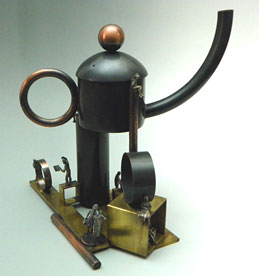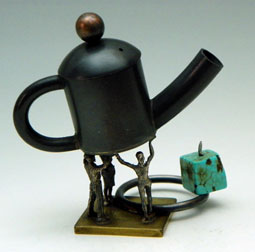Winged Camel Metalworks: Functional Copper Artwork with Unique, Whimsical Figures
 Copper and mixed metal teapot, Perplixi-Tea
Copper and mixed metal teapot, Perplixi-TeaPhotograph courtesy of Winged Camel Metalworks
J. Malcolm Owen and Mary Ann Spavins met at SUNY Oswego where both obtained masters degrees. Malcolm's background included a stint in the Alaskan bush and living on a houseboat in New York Harbor. A self-taught welder, he learned blacksmithing and did decorative ironwork. Mary Ann discovered metalworking techniques and taught. Mutual artistic interests brought them together. They married in 1976.
In Syracuse, Malcolm worked as an auto body technician and Mary Ann pursued metalworking, exhibiting at the Rhinebeck fair to begin building a clientele. Eventually, they purchased 18 acres of rural land at the foot of the Adirondacks near the Canadian border. They built a garage with an apartment above for their studio and have steadily been constructing a home on the property.
Mary Ann attributes their long, successful partnership to the fact they have separate studios. "Malcolm works out of the garage and I use the completed basement in our house," she says. "He'll make the clock barrels and other parts then bring them over to me. He loves tools and has produced many of the stakes and hammers we use daily. I create themes, lay out jewelry and smaller pieces. He enjoys mechanical aspects and larger sculptural/decorative art. Everything we do is completely handmade and involves collaborative effort."
 3 to the Power of Tea. Copper, brass, sterling silver, turquoise.
3 to the Power of Tea. Copper, brass, sterling silver, turquoise. Photograph courtesy of Winged Camel Metalworks
The lost wax method for creating the tiny silver figures on much of their artwork starts with designing rubber molds which are injected with wax then encased in plaster. Wax is melted in a kiln, hot molten silver is poured into the opening in the plaster until it is cooled, then cracked away.
"When the cost of silver skyrocketed, I started using more copper," she recalls. "I like copper's malleability and its non-ferrous properties. It also doesn't tarnish. On my jewelry, I mix copper with gold-filled wire to contrast color variations. We use a combination of local suppliers, found objects and on-line distributors to acquire 3" copper pipes and consolidated sheet metals. We've sometimes purchased plumbing fittings at auctions. Our hot and cold connections utilize oxyacetylene, hot silver solder and plumbing solder at various temperatures, often lower so it doesn't anneal."
Their fully-functional clocks are a combination of copper, brass elements, tiny sterling silver figures. To create their signature look, they apply a patina of sulfurated potash to the entire piece (clocks, office accessories or teapots) giving the copper a dark finish. Once the patina dries, a paste wax is applied to produce a durable, permanent finish.
They began creating teapots serendipitously, at the recommendation of a gallery owner.
"I had produced small copper cans for watering potted bonsai trees," she recalls. "Then, a gallery in Massachusetts suggested we enter their teapot show. I designed collectible teapots of copper and brass in limited editions of 25 with sterling silver standing figures about 3/4" tall. We cut pipe to lengths of 5" by 1" or 2" and use silver solder to connect the base and spouts. Many of the figures are on a base or block, designed for strength. Ultimately, everything is put on the piece with soft solder. They do hold water and pour well but are for decorative purposes only."
A few teapots can be seen at "Hot Tea" in St. Louis, MO, through April, 2012 and their artwork was shown last November at Paradise City Arts Festival in Marlborough, MA, where they hope to exhibit again this winter.
Resources:
Also in this Issue:
- Making History: The Civil War Reproductions of Hanover Brass
- Nothing Fishy: The Copper Work of R. Hanes Hoffman
- Cincinnati Art Museum Welcomes New Bronze Sculpture
- Grace Gunning: Capturing Time, Box by Box
- Winged Camel Metalworks: Functional Copper Artwork with Unique, Whimsical Figures
